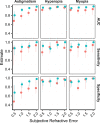Accuracy of autorefraction in an adult Indian population
- PMID: 34010350
- PMCID: PMC8133404
- DOI: 10.1371/journal.pone.0251583
Accuracy of autorefraction in an adult Indian population
Abstract
Purpose: Autorefractors allow non-specialists to quickly assess refractive error, and thus could be a useful component of large-scale vision screening programs. In order to better characterize the role of autorefraction for public health outreach programs in resource-limited settings, the diagnostic accuracy of two autorefractors was assessed relative to subjective refraction in an adult Indian population.
Methods: An optometrist refracted a series of patients aged ≥50 years at an eye clinic in Bangalore, India using the Nidek ARK-900 autorefractor first, followed by the 3nethra Royal autorefractor, and then subjective refraction. The diagnostic accuracy of each autorefractor for myopia, hyperopia, and astigmatism was assessed using subjective refraction as the reference standard, and measures of agreement between refractions were calculated.
Results: A total of 197 eyes in 104 individuals (mean age 63 ± 8 years, 52% female) were evaluated. Both autorefractors produced spherical equivalent estimates that were on average more hyperopic than subjective refraction, with a measurement bias of +0.16 D (95%CI +0.09 to +0.23D) for Nidek and +0.42 D (95%CI +0.28 to +0.54D) for 3nethra. When comparing pairs of measurements from autorefraction and subjective refraction, the limits of agreement were approximately ±1D for the Nidek autorefractor and ±1.75D for the 3Nethra autorefractor. The sensitivity and specificity of detecting ≥1 diopter of myopia were 94.6% (95%CI 86.8-100%) and 92.5% (95%CI 88.9-97.5%) for the Nidek, and 89.2% (95%CI 66.7-97.4) and 77.5% (95%CI 71.2-99.4%) for the 3Nethra. The accuracy of each autorefractor increased at greater levels of refractive error.
Conclusions: The sensitivity and specificity of the Nidek autorefractor for diagnosing refractive error among adults ≥50 years in an urban Indian clinic was sufficient for screening for visually significant refractive errors, although the relatively wide limits of agreement suggest that subjective refinement of the eyeglasses prescription would still be necessary.
Conflict of interest statement
The authors have declared that no competing interests exist.
Figures


References
Publication types
MeSH terms
LinkOut - more resources
Full Text Sources
Other Literature Sources
Medical
Research Materials

